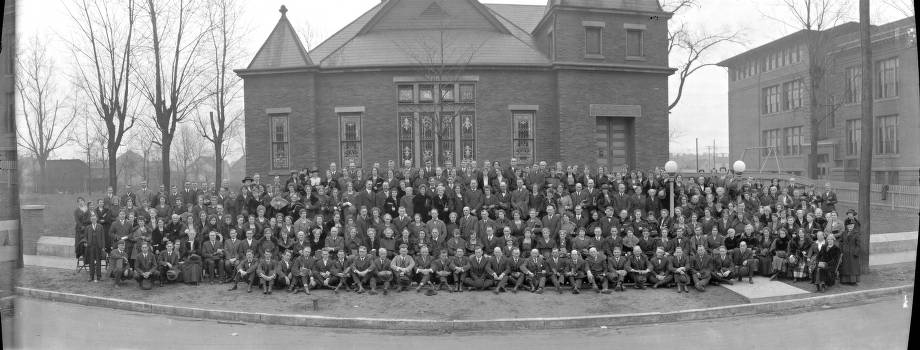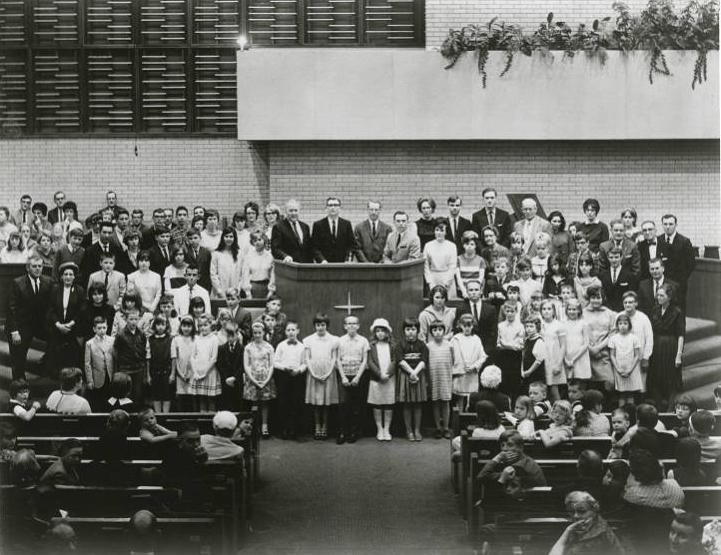Englewood Christian Church began in 1895 with 36 members on Rural Street on the eastern outskirts of Indianapolis, 100 yards north of the . A mostly white, working-class neighborhood grew up around the church as Indianapolis expanded and surrounded it. Many residents worked at nearby and at an plant that manufactured electronics and pressed records.

During the first decades of the 20th century, Englewood Christian flourished, but the early years did not come without controversy. On June 1, 1923, the church’s pastor, F. E. Davison protested an event held at Englewood’s meeting hall, which he described as a “100% meeting,” which referred to an anti-immigration slogan. Davison declared that the meeting, attended by about 6,000 people, was organized “for the dissemination of propaganda for the .” The organization gained prominence in Indianapolis and nationally by standing as a defender of American values—being “100 percent American.” It used such nativist propaganda to attract white Protestant members in the city and nationally. On June 12, 1923, a majority of the Englewood congregation forced Davison’s resignation because of his stance. The next day, 16 Indianapolis ministers adopted a resolution in support of Davison and stood with him in opposition to the Klan. Later that month, 400 people attended a reception held in his honor.
By its 50th anniversary in 1945, Englewood Christian had replaced its first wooden structure with an impressive brick building. In the decades immediately following World War II, the congregation became one of the largest in the U.S. and one of the largest of any kind in Indiana. By 1970, attendance at morning worship exceeded 1,000.

The church’s peak membership in the 1960s and early 1970s, however, coincided with the development of the interstate highway system that transformed it into an “inner-city” church. The interstate separated near-downtown communities like Englewood from an outer ring of suburban communities. By the 1970s, much of the industry that had supplied employment to area residents had vanished, and local businesses closed. Residents fled to the outer suburbs. The neighborhood’s housing stock—built mostly in the 1910s and 1920s—deteriorated. Demographics shifted, to 50 percent white, 25 percent African American, and 25 percent Hispanic. The pastor who had led Englewood during its megachurch phase of the 1960s left, and membership in the church dropped to 250 over the next two decades.
At a time when many congregations moved to new suburban locations, Englewood chose to remain at its original site. During the 1970s and 1980s, some members tried to revive the church by pursuing different forms of spiritual renewal while others sought ways to respond to the needs of the congregation’s increasingly impoverished neighborhood. Despite these efforts, the church floundered during the 1980s and early 1990s.
For its 100th anniversary in 1995 the church started Sunday evening conversations. Reverend Mike Bowling had been called from Pittsburgh as pastor, moving his family into the neighborhood. He and other Englewood leaders saw opportunities where others saw problems. Under his leadership, the congregation developed many new ministries—childcare, a police substation, and Alcoholics Anonymous meetings.
With the aim of increasing its capacity to address such issues as housing, employment, household finance, food, education, and childcare, church members established the Englewood Community Development Corporation in 1996. The separate 501(c)(3) corporation linked to the church has created opportunities such as first-time home ownership and low-income rental options in . Some church members also have helped move a nearby public school, the Thomas Gregg Neighborhood School, to innovation status in the system.
Englewood Christian partners with such organizations as the John Boner Neighborhood Centers, the , Outreach Hope for Homeless Youth, and Exodus Refugee. In 2021, the church received a grant from the Lilly Endowment, Inc. for its summer daycare program for school-age children.

Help improve this entry
Contribute information, offer corrections, suggest images.
You can also recommend new entries related to this topic.